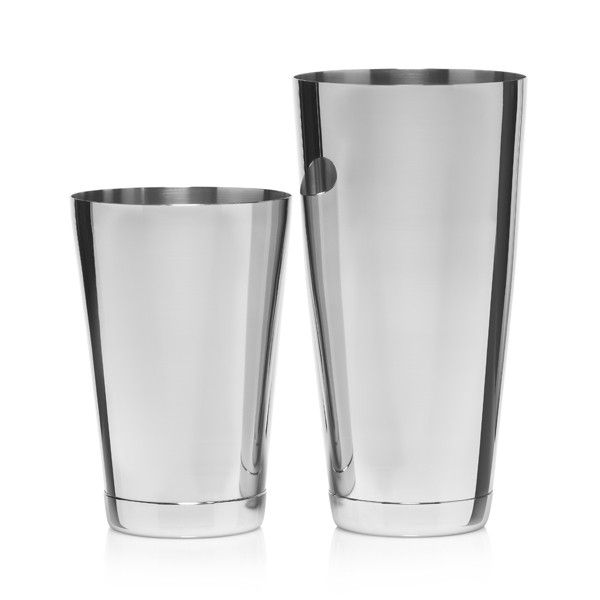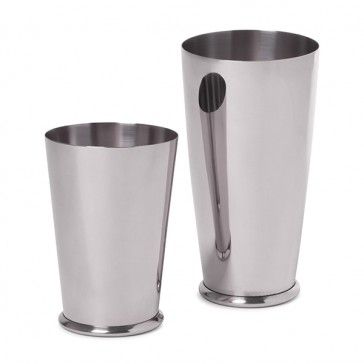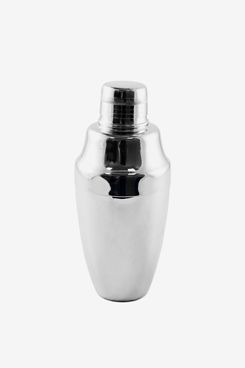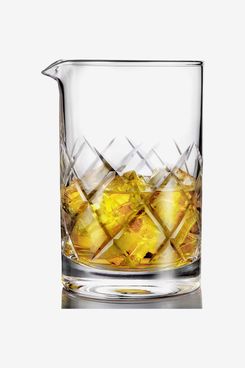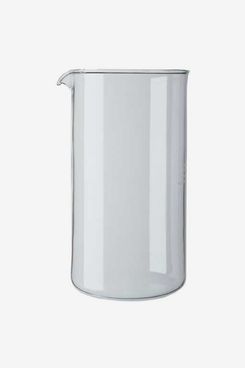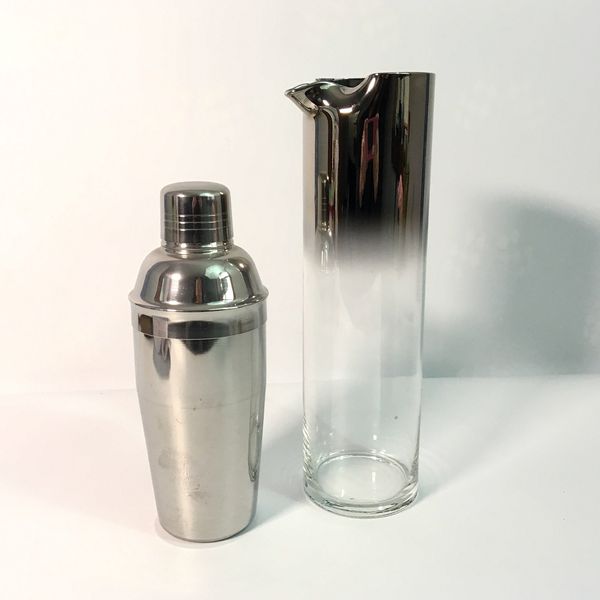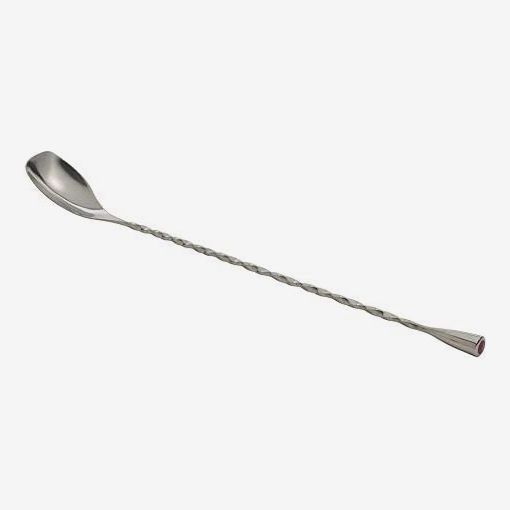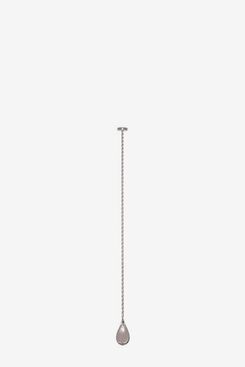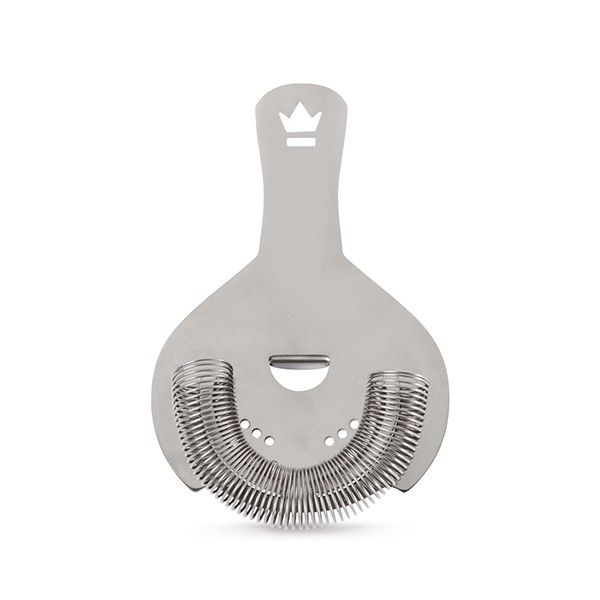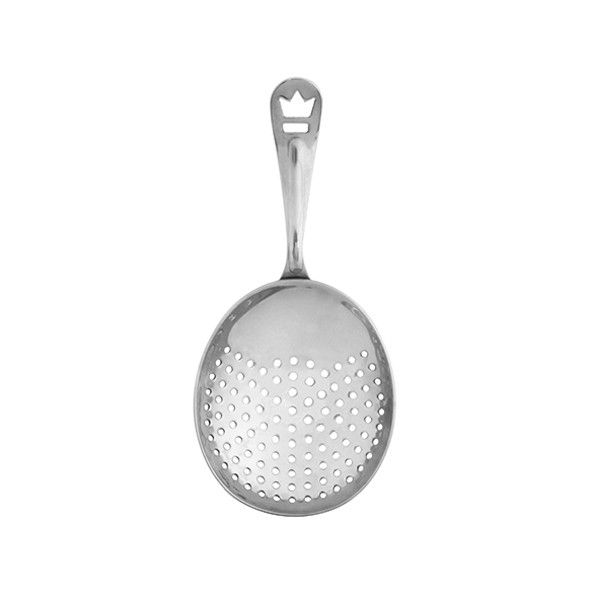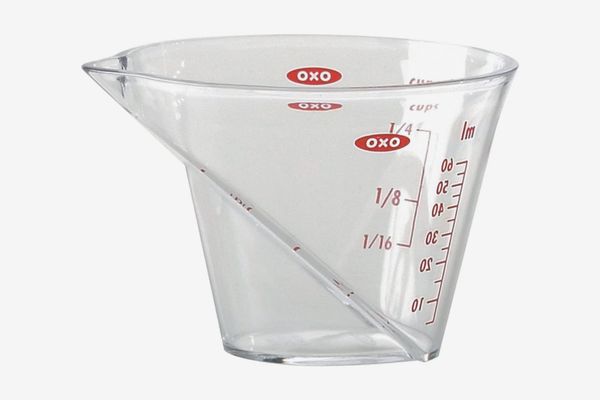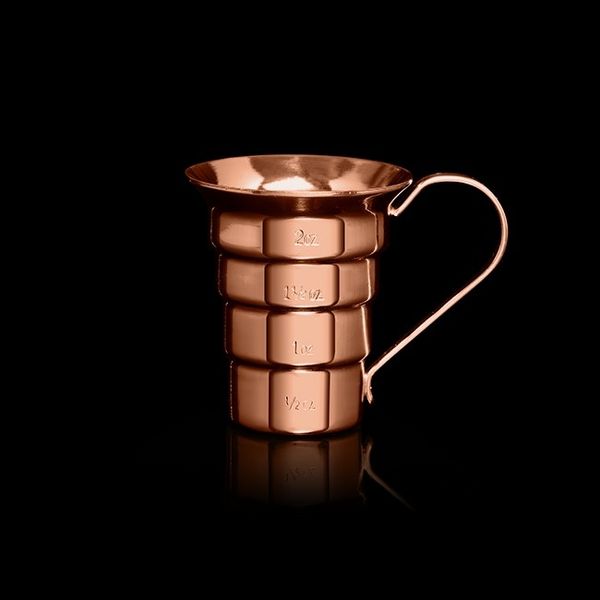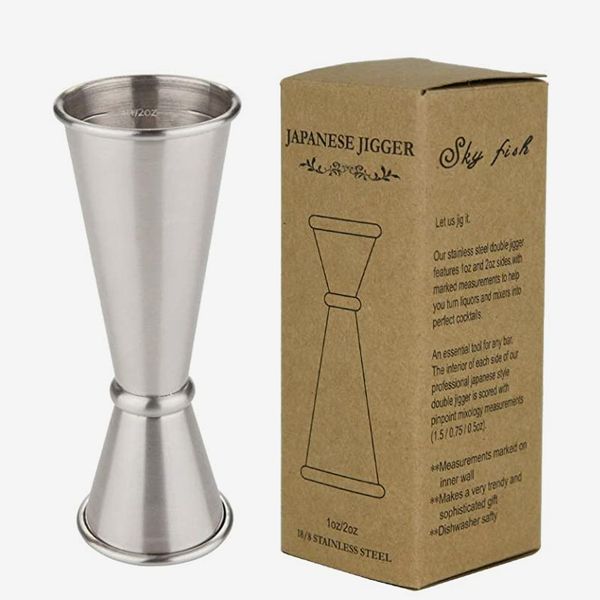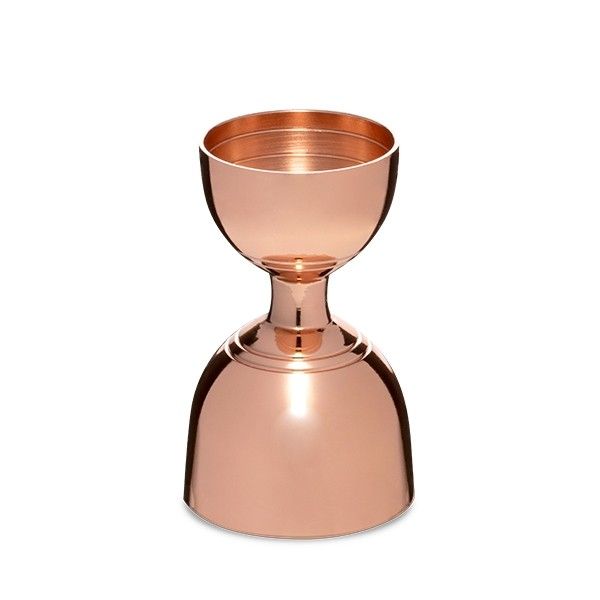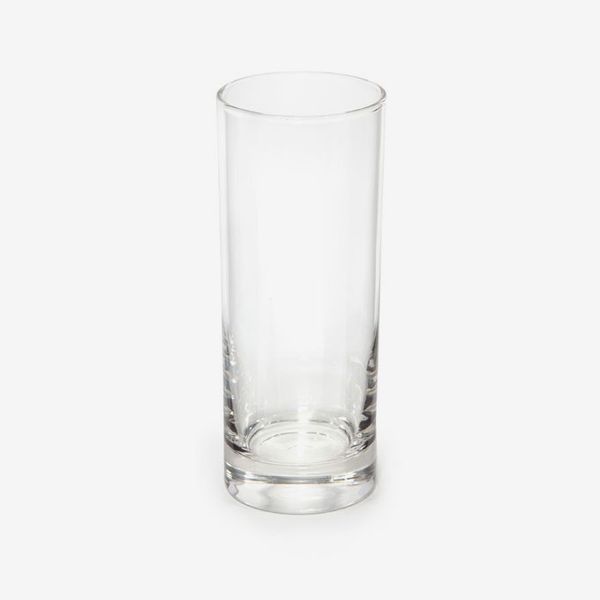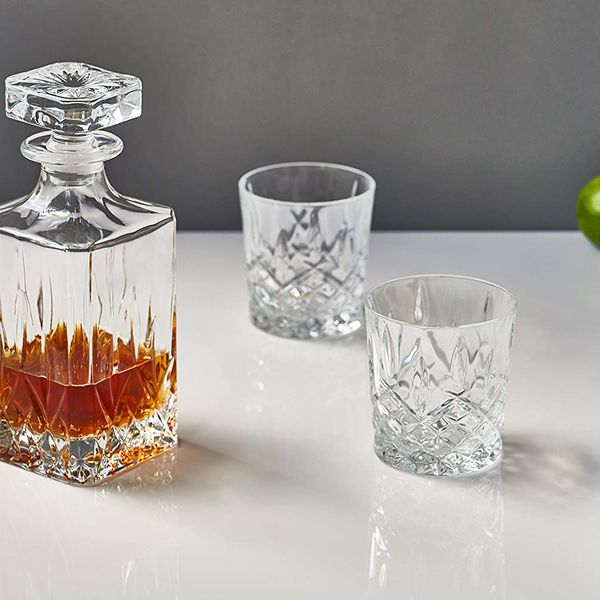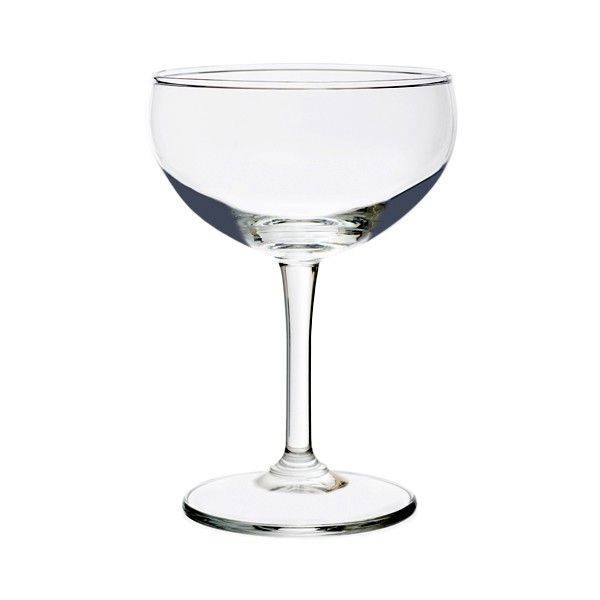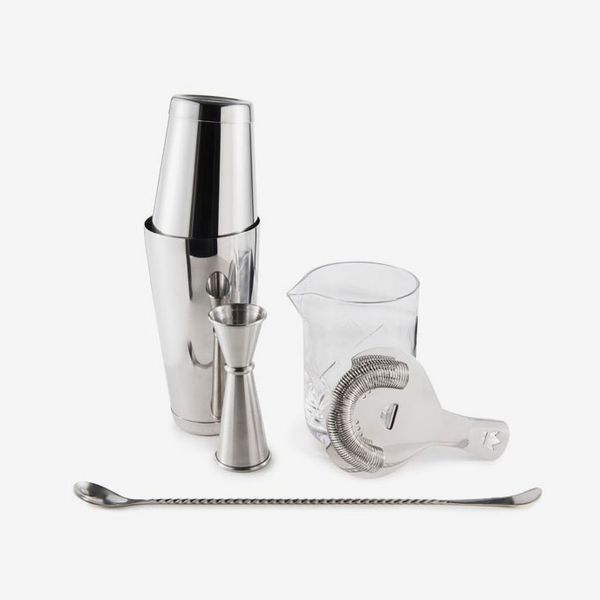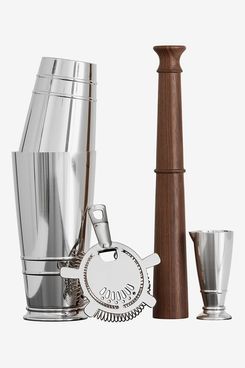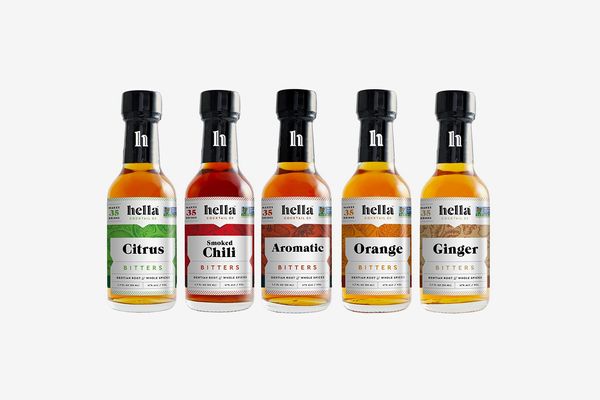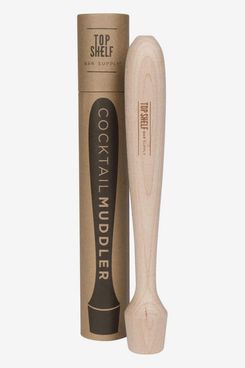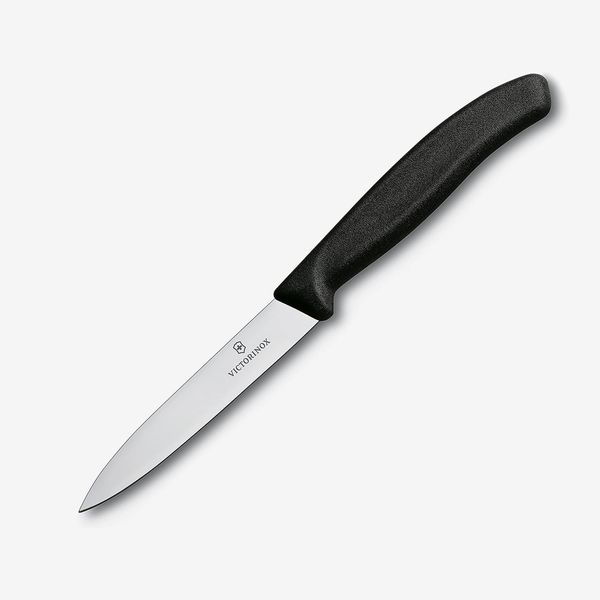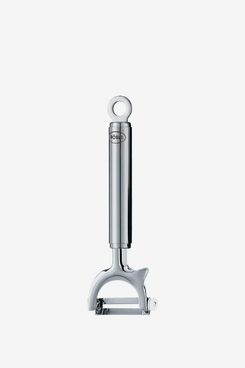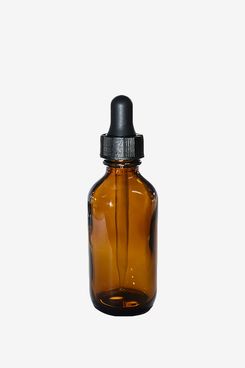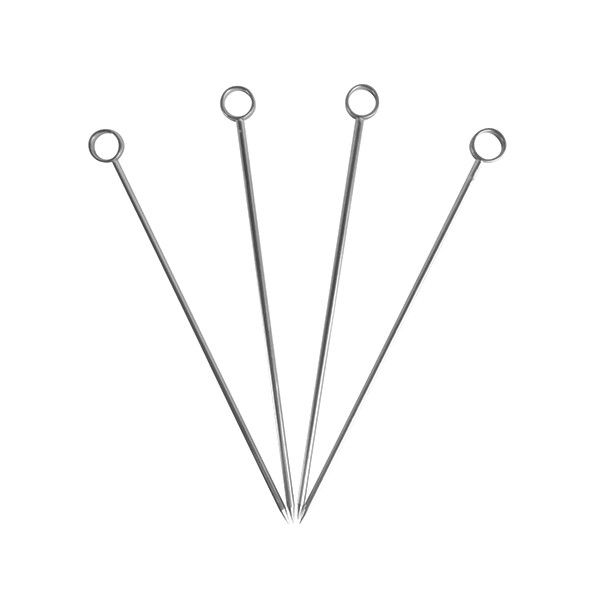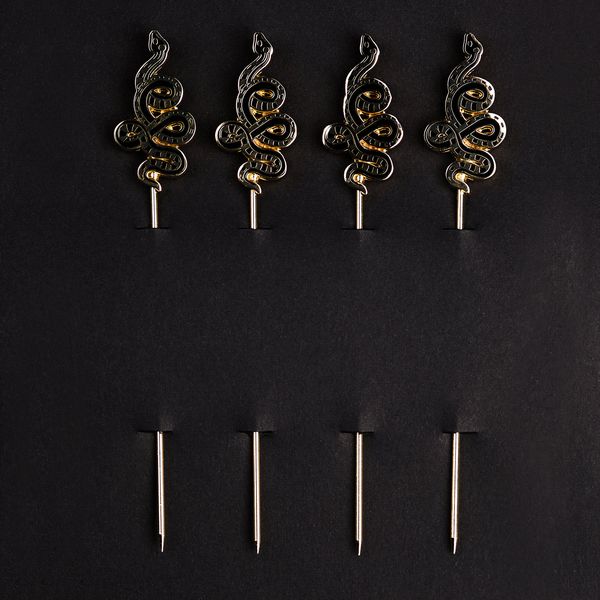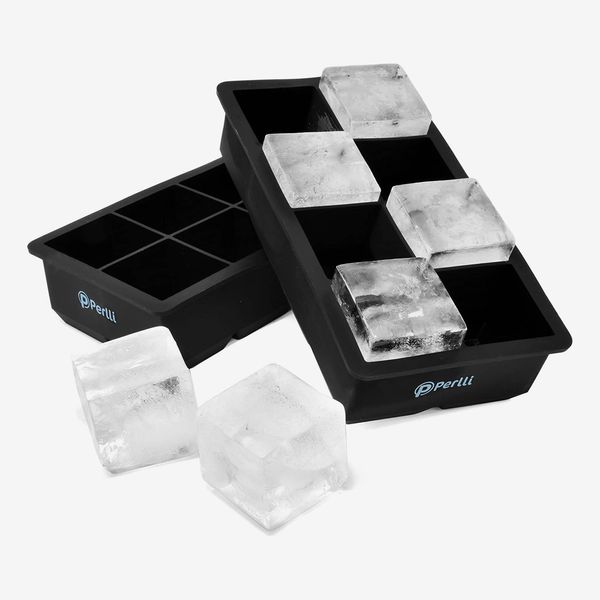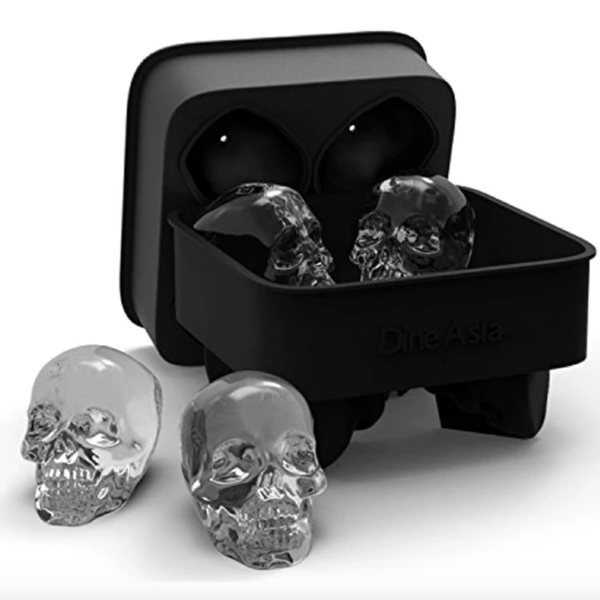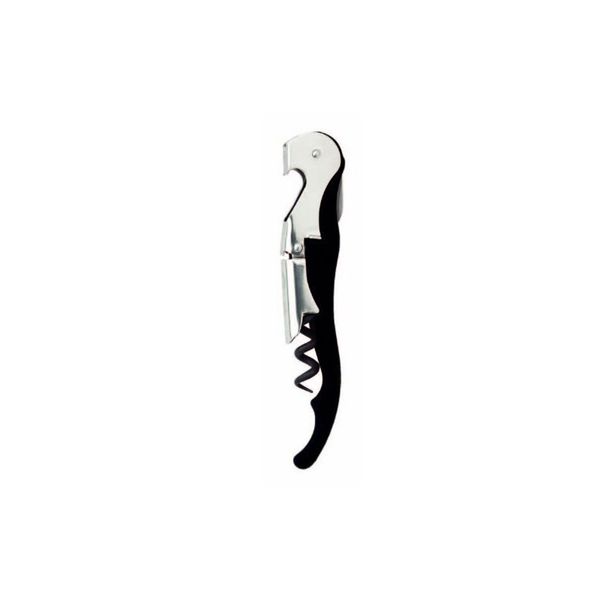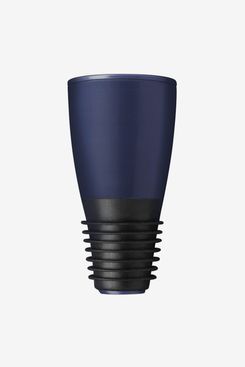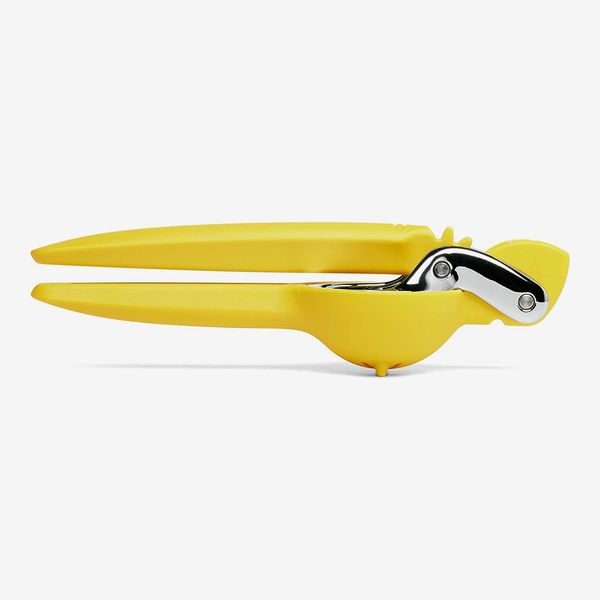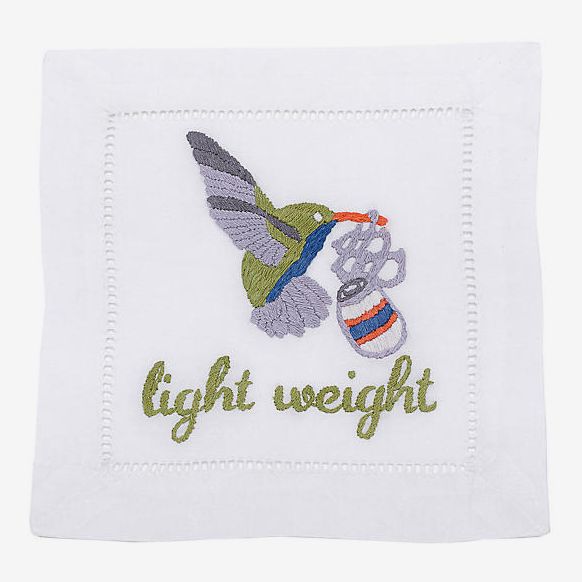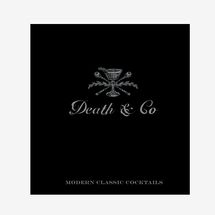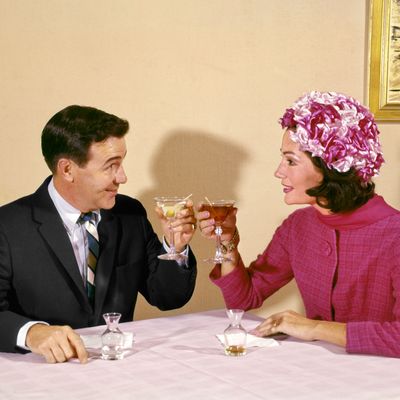
So you finally found the bar cart of your dreams, and you’ve loaded it up with your favorite liquor. While those are two very important steps to curating an at-home bar, to really make your setup recall that of your favorite watering hole, you’re going to want to add some barware and cocktail equipment. But that can be an intimidating task, especially if you’ve had more experience drinking cocktails than making them. The good news is that you don’t have to spend a lot of money. “Most people in their home bar really don’t need that many tools,” advises Joaquín Simó, a partner at New York City’s Pouring Ribbons who was named Tales of the Cocktail’s American Bartender of the Year in 2012. “I say you start with the absolute basics and concentrate on the things that you like to use.”
If you’re in a pinch, Martin Hudak, a bartender at Maybe Sammy, says you can always use tools you may already have on hand: “For your shaken cocktails, you can use empty jam jars or a thermos flask. For measuring, spoons and cups, and for stirring, any spoon or back of a wooden ladle.” But Stacey Swenson, the head bartender at Dante (which currently holds the No. 1 spot on the World’s 50 Best Bars list), notes that if you’re going to put stuff on display, you might want gear that’s both practical and stylish. “You want something that’s functional and also something that’s pretty,” she says. “If you’re putting it on your bar cart, you kind of put on a show for your guests.” With the help of Simó, Hudak, Swenson, and 28 other experts, we’ve put together the below list of essential gear for any cocktail-lover’s home bar.
Editor’s note: If you want to support service industry workers who have been impacted by the coronavirus closures, you can donate to the Restaurant Workers’ Community Foundation, which has set up a COVID-19 Crisis Relief Fund, or One Fair Wage, which has set up an Emergency Coronavirus Tipped and Service Worker Support Fund. We’ve also linked to any initiatives the businesses mentioned in this story have set up to support themselves amid the coronavirus pandemic.
Shakers
Best overall shaker
According to Simó, all shakers “technically do the same thing, and there are very cheap and very nice versions,” so there’s really no superior option when it comes to function. That said, many professional bartenders use Boston-style shakers, which are basically two cups that fit into each other and form a tight seal to keep liquid from splashing all over you. “If you want to look like a bartender at Death & Co. or PDT, and you want the same kit, then you’re probably going to go metal-on-metal,” or “tin-on-tin,” Simó notes. Six of our experts recommend these weighted tin-on-tin shakers — which come in a range of finishes, including copper and silver — from Cocktail Kingdom, a brand that nearly every bartender we spoke to praised for its durable, well-designed barware. Grand Army’s beverage director, Brendan Biggins, and head bartender, Robby Dow, call this “the gold standard” of shaking tins. “Behind the bar, there’s almost nothing worse than shaker tins that don’t seal well or don’t separate easily,” explains Krissy Harris, the beverage director and owner of Jungle Bird in Chelsea. “The Koriko Weighted Shaking tins seal perfectly every time and easily release,” she says. And because they’re weighted, they’re less likely to fall over and spill.
Best shaker for beginners
While most bartenders use Cocktail Kingdom’s Koriko tins, bartender Tim Cooper, who is also the head of brand advocacy for Fords Gin, says that the Leopold shaker is his favorite. “In my experience, the tins are easier to separate than the Koriko’s and feel a touch lighter, as well,” he says. “They’re simply more efficient,” adds Cooper, which is why he says this is a great option for the at-home bartender who’s not well versed on using shaker tins.
Best shaker with a built-in strainer
For some people, a two-piece setup like the above shakers might be tricky to use comfortably. “Say you’re a petite female — if you have very small hands, then maybe using a Boston-style shaker may be a little harder,” explains Simó. In that case, a cobbler shaker may be the better choice, because it’s smaller than a Boston-style shaker and thus easier to hold. The other convenient part of a cobbler-style shaker is that the strainer is already built into the lid, so you don’t necessarily have to spring for an additional tool. Karen Lin, a certified sommelier, sake expert, and the executive general manager of Tsukimi, suggests this shaker from Japanese barware brand Yukiwa. “The steel is very sturdy, and the shape fits perfectly in my hands,” she says. “It is also designed well so you can take it apart easily to clean.”
Mixing glasses
Best overall mixing glass
You know how James Bond always ordered his martinis shaken, not stirred? Well, if you were to ignore Mr. Bond’s order and make a stirred martini — or any other stirred cocktail, like a Negroni or a Manhattan — you’d set aside the shaker to use a mixing beaker instead. A mixing beaker is essentially a large vessel in which you dump your liquors and mix your drink. And though you can purchase handsome crystal ones for hundreds of dollars, both Simó and Swenson agree that they’re kind of superfluous for a basic bar kit. “I don’t think you should spend any more than $25 on a mixing glass,” says Swenson. Harris agrees, saying that since they are the most broken item behind the bar, you should stick to a well-priced option like this mixing glass from Hiware that “doesn’t have a seam, so it’s stronger and very attractive.”
Best nontraditional mixing glass
One of Simó’s hacks to getting a glass mixing beaker for not that much money is to use the glass piece from a French press, which is something else you might already own. If you want a dedicated one for your bar cart (that could serve as a backup for your French press), he says you can buy a replacement glass like this one, which has a capacity that is particularly useful if you’re making drinks for a lot of people. “I generally will take one or two of the big guys with me when I’m doing events, because then I can stir up five drinks in one, and it’s really convenient,” Simó explains.
Best pitcher
According to Paul McGee, a co-owner of Lost Lake in Chicago, “finding vintage martini pitchers is very easy, and they are perfect for making large batches of cocktails.” Plus, they’ll look more visually striking on your bar cart. This one is even pretty enough to use as a vase when it’s not filled with punch. The photo shows the pitcher next to a strainer, but you’re only getting the pitcher for the price shown.
spoons
Best Japanese-style bar spoon
If you’re making a stirred drink, a mixing or bar spoon is also necessary. “Three basic styles exist: the American bar spoon has a twisted handle and, usually, a plastic cap on the end, the European bar spoon has a flat muddler/crusher, and the Japanese bar spoon is heavier, with a weighted teardrop shape opposite the bowl,” explains Joe Palminteri, the director of food and beverage at Hamilton Hotel’s Via Sophia and Society. None of our experts recommended specific American-style bar spoons, but Simó told us that one of his favorite Japanese-style spoons is this one made by bartender Tony Abou-Ganim’s Modern Mixologist brand. “It’s got a really nice, deep bowl to it, which means you’re able to measure a nice, level teaspoon” without searching through your drawers, according to him. Simó continues, “The little top part of it has a nice little weight to it, but it’s not too bulky. So it gives you a really nice balance as you’re moving the mixing spoon around,” making your job a little easier.
Best European-style bar spoon
Should your at-home bartending require a lot of muddling, Swenson recommends getting a European-style spoon like this, which he says will still allow you to stir while eliminating the need to buy a dedicated muddler. “You can actually use the top of the spoon to crush a sugar cube if you wanted to for your old-fashioned. I have one of those, so I don’t have to have two tools; I’ve got both of them right there.”
Strainers
Best overall strainer
You don’t necessarily need a strainer if you’re using a cobbler shaker, since it’s already got a strainer built into the lid. But if you’re using a Boston-style shaker, you should get what’s called a Hawthorne strainer to make sure the ice you used to chill your drink doesn’t end up in your glass and dilute the cocktail. Three experts recommend this one, including Lynnette Marrero, the beverage director of Llama Inn and Llama-San and the co-founder of Speed Rack, who says it’s her absolute favorite because “it is light and easy to clutch and close correctly.” If you choose to buy this Hawthorne strainer, Simó also recommends getting “the replacement springs that Cocktail Kingdom sells,” telling us they’re a good way to give a worn-out strainer a face-lift. “They’re really, really nice and tight, and you can generally slip them into any Hawthorne strainer that you have.”
Best less expensive strainer
A slightly less expensive strainer is this Cocktail Kingdom julep strainer that three of our experts — Woodford Reserve Brand Ambassador Random Ward; Padraig Confrey, the beverage director at Grupo Gitano; and Harris — also recommend. Generally, julep strainers will offer a better fit than Hawthorne strainers if you’re using a mixing glass to make your drinks. According to Cohen, a julep strainer can work equally well in the kitchen, because it “doubles as an ice scoop if needed, too.”
Jiggers
Best overall jigger
A jigger is what you use to measure the liquor into the shaker or mixing glass. A hyperfunctional, albeit nontraditional-looking, option is the mini measuring cup from OXO. “I know some bartenders, including the ones at Drink in Boston, one of the best bars in the country, swear by those graduated OXO ones because they love the ability to read them from both the sides and the top,” explains Simó. “You can measure in tablespoons or ounces or milliliters, and it’s all on the same jigger.” Part-time bartender Jillian Norwick and Ward both love it too and keep the stainless steel version on hand (which looks a little nicer when left out). Noriwck adds that she’s in good company: “The peeps at Bon Appétit love it.”
Best stepped jigger
This fancy-looking jigger combines the functional appeal of the OXO measuring cup (it’s basically a cup that grows wider to accommodate different amounts of liquid) with the aesthetic appeal of a classic bar tool. It also makes measuring a snap: “This handy measuring tool is super-easy to use and enables the imbiber to essentially build all the ingredients of a drink in one go,” says Confrey.
Best traditional jigger
If you’re going for a more classic look but still want something practical, Simó recommends this double-sided metal jigger that has a one-ounce cup on one side and a two-ounce cup on the other. The one-ounce side on this strainer also has a half- and three-quarter-ounce lines etched into it to make it even more precise. “That gives you a lot of wiggle room” and will allow you to measure for most basic cocktails, Simó says. “From there, you really just have to learn what a quarter-ounce looks like in there, and you’re pretty much good to go.”
Best Leopold jigger
Biggens, Dowe, and Swenson prefer a Leopold jigger, which has a unique bell shape (with one bell holding an ounce, and the other two ounces) as well as lines etched on the inside marking both quarter- and half-ounces. “They’re really easy to hold and they have some weight to them,” Swenson adds. “Somebody who’s not really experienced using a jigger is going to be fine with something with a little bit more weight to it. And they look cool.”
Glassware
Best collins/highball glasses
Though it’s easy to want to get a different type of glass for every type of drink you make, that’s really unnecessary when you’re first starting out. According to Simó, “You can make 90 percent of drinks into a good, all-purpose cocktail glass like a rocks or a collins glass.” (While this section contains our bartenders’ favorite glasses, if you want to shop around, you can find most of these styles at various price points in our list of the best drinking glasses.) A collins — or highball — glass is the one that looks like a chimney, and generally you’re looking for something that’s about 12 ounces, like these collins glasses from bartender-favorite brand Cocktail Kingdom. “You don’t want a 16-ounce Collins glass because you’re going to be hammered after your second Tom Collins,” advises Simó.
Best rocks glasses
For a rocks glass, Simó says the ideal size is between eight and ten ounces. “That’s enough where you could put a decent-size chunk of ice in there if you like making the fancy ice,” he explains. This set of four rocks glasses recommended by Theo Lieberman, the beverage director of 232 Bleecker, is slightly larger at 11 ounces each (more room for fancy ice), and he says they’re durable, machine-washable, and look good to boot. “No one likes taking all the time to make a cocktail and then just putting in a boring glass,” he says.
Best coupe glasses
If you’re looking for glassware beyond the basic collins and rocks glasses, Swenson suggests adding some coupe, or bell-shaped, glasses to your setup, because they’re more forgiving than a V-shaped martini glass (which, she adds, are “super out of style” these days). “The curve on a coupe holds the liquid in a little bit more, so if you get jostled, the liquid is more likely to slosh within the glass but stay in the glass,” Swenson explains. “They’re sleek, they’re smaller, and they look a lot classier than a martini glass.” A coupe glass should be somewhere between six and eight-and-a-half ounces, advises Simó. Nate Fishman, the brand ambassador for Santera Tequila and a bartender at Liquor Lab, likes these six-ounce coupe glasses, telling us that, in his opinion, “everything tastes better out of a coupe glass.”
sets
Best overall bar-tool set
Instead of shopping à la carte, Johnny Swet, the owner of Brooklyn’s Grand Republic Cocktail Club and a bar consultant for Jimmy at the James and The Skylark, says that Cocktail Kingdom sells many of the above tools as part of this set. It includes a spouted mixing glass, weighted metal shaker tins, Japanese jiggers, bar spoons, and a Hawthorne strainer (or everything you need to make a drink at home). If you want to be really fancy, you can even get it in copper or gold.
Best less expensive bar-tool set
For a more affordable set, Marrero suggests this really “nice at-home barware set that includes a shaker, muddler, strainer, and jigger.”
More expert-approved gear for your at-home
“The world of bitters is massive, and there is so much variety available on the market now,” says Four Seasons Hotel New York beverage director Cara Maldonado. To stock up on several profiles of bitters without breaking the bank on larger individual bottles, Cooper says to try this variety pack, which includes aromatic, citrus, orange, smoked chili, and ginger bitters. “It’s great for the budding home bartender that they can use to experiment with.” Linden Pride, a co-owner of Dante, is also a fan of stocking a bar cart with several types of bitters like those found in this set.
If you do want a proper muddler (not just a muddling spoon) to make drinks that require sugar cubes, herbs, or fruit (like old fashioneds, mojitos, or Brambles), Harris prefers an old-school, wood style. “As long as it’s rinsed and left to dry, it shouldn’t crack,” she says.
According to cocktail expert and global brand ambassador for Absolut Elyx Gareth Evans, “When you’re making drinks for friends, remember that the first sip is with the eye, and this is where a good, sharp knife comes in to make sure your garnishes look fresh.” He suggests this non-serrated paring knife from Victorinox, which he says “is the bartender staple around the world.”
Though there are some tools that are specifically designed to make garnishes, most home bartenders will be set with a vegetable peeler. Rösle peelers, though more expensive, are “insanely sharp — they are built like tanks,” says Simó, “and they will last for a long time. So if aesthetics matter, those are really, really spectacular, and I would highly advise one.” If aesthetics don’t matter, Biggins says a regular vegetable peeler works just as well, naming the simple, Strategist-approved vegetable peelers from Swiss kitchenware company Kuhn Rikon as a favorite (Norwick and Dowe are both fans too).
Kris Peterson of Chicago’s Mordecai and Hush Money calls these glass droppers “indispensable to cocktails,” because they allow you to make drinks with more precision. “Dasher bottles can sometimes be clumsy and inconsistent,” he explains, adding that droppers are especially useful with ingredients like crème de violette or maraschino or Chartreuse that can take over a drink without a light touch.
For garnishes, Paula November, the event vice president of Reed Exhibitions and Bar Convent Brooklyn, loves these sleek-looking, reusable picks for topping off a cocktail.
If you’re looking for a pick with personality (that isn’t an umbrella), Katipai Richardson-Wilson, the owner of Gowanus bar Dirty Precious, “uses these stylish snake cocktail picks if I’m showing off.” She promises that they’re “guaranteed to kick even the most delicious cocktail up a notch.”
“At home, I just have the two-by-two ice-cube trays,” says Swenson. “I don’t stress with making them perfectly clear, but if you want to take the time to do that, that’s totally fine.” According to Simó, basically any style of ice-cube tray you have at home will likely yield better ice than you’d get at an actual bar. “For the most part, you will make better ice in your home freezer using even standard ice molds,” he says. That’s because most commercial ice machines produce ice that “is designed to stack on each other and take up a lot of room, but has so much surface area that it melts really quickly” and dilutes your drink. If you’re looking to add a bartender-approved ice tray to your freezer, Lieberman says that these molds are “easy to use and clean,” and make 2.5x2.5-inch cubes that are great for any cocktail or just whiskey on the rocks.
Those who want ice with a bit of flair should consider these skull-shaped ice cubes that Rob Dietrich, the master distiller at Blackened American Whiskey, uses at home. “The large surface melts slow, offering a less diluted beverage,” he says. His other tip: Use filtered water when making your ice to get the best taste.
“A good wine key is invaluable,” says Simó, though you don’t necessarily need to spend much money on one. He recommends getting one with a serrated blade (to take the foil off of the bottle) and coated coil, because it’ll go into the cork more smoothly. “The kind that have the hinged little portion that you can get halfway through the pull and then re-lock it to get the other half in, those are very forgiving because it gives you two different angles at which to get the cork out perfectly vertically,” he adds.
Should you be eyeing an expensive Coravin to preserve any wine bottles you uncork at home, Matt Crafton, a winemaker at Chateau Montelena, says this RePour wine saver does good a job at keeping your unfinished bottles fresh for a fraction of the cost. “They’re inexpensive, dead simple, and effective.”
“The only way to get good lemon and lime juice is to take a small, round, fresh green or yellow thing, cut it through the equator, and then put it into a juicer and ream it and use it that day,” says Simó. “You can’t use it the next day. It gets really bitter and oxidized and gross.” That’s why he says having a handheld juicer is so important if you’re trying to up your home-cocktail game. Ivy Mix — the owner of Leyenda in Brooklyn, a co-founder of the all-female bartending competition Speed Rack, and the author of the forthcoming book Spirits of Latin America — agrees: “Having a fantastic juicer on hand is a must.” Biggins and Dowe say this handheld juicer is the “best of the best,” because it’s efficient, sturdy, and gets the most juice out of your citrus. If you want something more powerful, Brian Evans, the director of bars at Sunday Hospitality, says an “easy-to-operate beast” like the Breville electric juicer will up your mixology game a notch by allowing you to juice vegetables and fruits, instead of just simple citrus.
“For useful décor, I love to serve drinks on vintage cocktail napkins,” says Allen Katz, a co-founder of New York Distilling Company. “They are a great escape and a conversation piece at the same time.” Vintage linens (or anything) are typically one-of, and Katz did not name a favorite style or seller, so if you’re looking for a napkin that doubles as a conversation starter, might we suggest these embroidered ones from August Morgan, which contributor Chloe Malle says should appeal to “shameless pun-thusiasts.”
Just like you keep a coffee table book in the living room and a cookbook in the kitchen, you can display a cocktail book on your bar cart. Evans calls this “one of the most invaluable cocktail books ever released,” as well as a “treasure trove like no other.” Cocktail Codex is a James Beard Award–winning book that “lays out a wide spectrum of techniques, flavor pairings, and spirits knowledge that really speak to the professional mixologist as effectively as the casual home bartender,” he explains.
“There are endless books on the subject of cocktails, and I want them all,” says Maldonado. She has a rotation of “informative and beautiful” tomes that she keeps on her own home bar, including Death & Co and The Drunken Botanist as well as Cocktail Codex. “Friends love thumbing through them” while she entertains, she adds.
The Strategist is designed to surface the most useful, expert recommendations for things to buy across the vast e-commerce landscape. Some of our latest conquests include the best dining room decor items, coffee makers, knife sets, Japanese coffee brewer, charcoal water filter, and drinking glasses for water and more. We update links when possible, but note that deals can expire and all prices are subject to change.
Every editorial product is independently selected. If you buy something through our links, New York may earn an affiliate commission.
